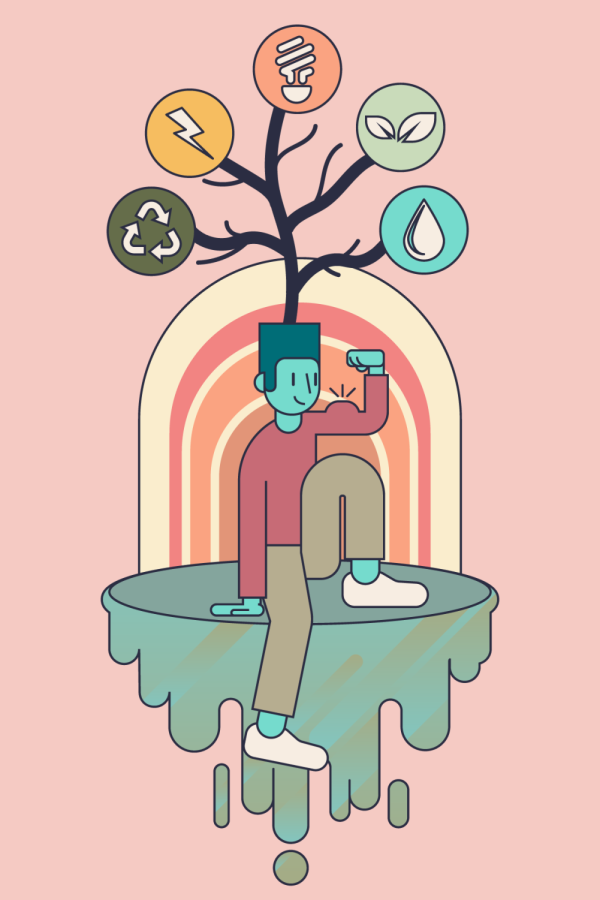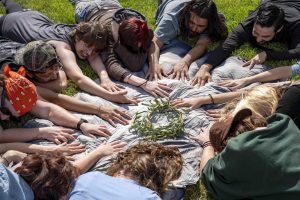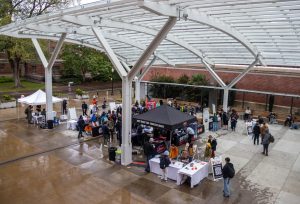- Beavers Digest / Cascades
- Beavers Digest / Cascades / Culture
- Beavers Digest / Cascades / Experience
- Beavers Digest / Culture
- Beavers Digest / Culture / Expression
- Beavers Digest / Experience
- Beavers Digest / Experience / Campus
- Beavers Digest / Experience / Create
- Beavers Digest / Experience / Outdoors
- Beavers Digest / Experience / Wellness
Improving sustainability at OSU using your ‘passion and drive’
By Teresa Aguilera, OMN Illustrator
Sustainability and sustainable decision-making can vary among college students. It can be difficult to be aware of and track your carbon footprint but even little mindful actions can make a difference. “Sustainable decision-making is like a muscle, you must practice it to get better, and you should start small,” says Jena Thoma.
April 22, 2022
“What can we do to improve our sustainability? How can you help make that change?” posed Alicia Leytem, an instructor at Oregon State University. Thinking these questions to yourself can be the first step in working to live a more sustainable life.
Although living sustainably as a college student can be tricky, from a busy schedule to a lack of money, there are always strategies to incorporate into your daily routine.
“In some ways, it’s easier and in some ways it’s harder,” said Dr. Lorien Reynolds, a senior instructor at OSU, in regards to living sustainably as a student.
Reynolds noted that since students are at the beginning stage of life when they begin to make their own decisions, it can be easier to get into a sustainable routine and live how you want to. Additionally, most students must work to conserve their money, which leads to less consumption, a major contributor to one’s ecological footprint.
Reynolds said, “When we look at things like carbon footprint or ecological footprint or water footprint, oftentimes college students’ numbers will be below average, because they’re not yet at the point where they’ve maximized consumption for their particular demographic.”
However, Reynolds addresses that at the same time this lack of money can prevent one from choosing sustainable options, which oftentimes are more expensive.
Jena Thoma, a graduate teaching assistant at OSU, agreed. According to Thoma, it can be easier to reduce emissions if you live on campus and walk, bike or skate to class. However, she said a challenge was, “as a student living in the dorms, you don’t have the option of choosing energy-efficient appliances or building materials.”
Additionally, Leytem acknowledged that students are often tired and stressed which can make it hard to have the effort to be sustainable.
Whatever the situation may be, there are ways to work towards a brighter future.
Thoma gave some suggestions such as, “you can try to incorporate more plant-based meals into your diet.” Thoma said this could be done by eating two or three plant-based meals each week. She added that taking shorter showers also helps to reduce water consumption.
Leytem said good strategies are, “choosing to eat less meat and dairy, trying to buy produce that is seasonal and locally grown, buying used clothes and products rather than new and walking, biking or utilizing our free public transport in town.”
Thoma offered some advice on how to get in the rhythm of this, “sustainable decision-making is like a muscle, you must practice it to get better, and you should start small.”
Thoma assured that living sustainably doesn’t mean changing everything. “Being mindful of the impact that even the most minute decisions have on the world around us, and then letting that inform and motivate your actions, is the key to beginning to live more sustainably,” she said.
Leytem encouraged focusing on the larger picture as well.
“Remember also that sustainability is not only focused on the environmental impacts of our decisions, but also the social and economic impacts they have,” Leytem said. “It’s one thing to try to make sustainable decisions on a day to day basis, but what is truly needed is for people to work on changing the scaffolding of our systems of power to create a more sustainable future.”
Leytem talked about how spending time in your college years to learn about these systems, working with others to imagine solutions to social, economic and environmental issues and exploring these challenging ideas, will overall, lead to a more sustainable world.
“Use your passion and drive to find ways to make a change in your community,” Leytem said.
Both Reynolds and Leytem talked about utilizing OSU’s sustainability office to become more educated on the topics. The office provides tools for this such as personal carbon, ecological and water footprint surveys that show students what their impact on the planet is. Additionally, the office works with programs such as waste watchers—a student run organization at OSU that aims to reduce waste and work with campus recycling.
“The other stuff [you can do] is just to become informed,” Reynolds said. “Find out what your ecological footprint looks like, what your water footprint looks like and what aspects of your lifestyle may be impacting that most, and then you can start having the power to actually start looking at those things and making those decisions,” Reynolds added.
OSU can play a role in this as well. Reynolds and Leytem acknowledged OSU’s strides in working to become carbon neutral.
“There is progress being made in making OSU more carbon neutral, sadly I don’t think we’ve been able to achieve certain things like carbon de-investment,” said Reynolds. “OSU has divested from fossil fuels. OSU is still working toward carbon neutrality, and a lot of our electricity comes from fossil fuels so that is a place where the university can improve over time.”
Another thing Reynolds noted that could be improved upon are to-go containers and food waste management. She said that before the COVID-19 pandemic, there was a lot of attention going towards the issue, which has currently been put on hold.
Thoma talked about how she would like to see better composting services around campus to reduce food waste and to see the dining halls source their food more locally. Additionally, she added that turning the heat down in OSU buildings will help conserve energy.
Reynolds said, “I think maybe one of the best things that OSU could do right now is just encouraging students to participate in these sustainability activities and getting students to tell us what it is they’re looking for, what they think is going to be the next big step and actually taking that step.”
Reynolds added, “There’s always room for improvement though, of course.”






